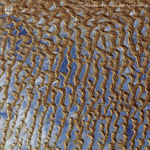|
|
 |
Dusted Reviews
Artist: Jessika Kenney & Eyvind Kang Album: The Face of the Earth Label: Ideologic Organ Review date: Jan. 23, 2013 |

|
|
|
 |
When I interviewed Eyvind Kang back in 2012, he spoke at length about the presence of duality in his music and how that served as a companion to similar reflections and doubles in the world at large: sound and its echo, people and their shadows, music and its reverberations... That theory was already explored on his previous LP with Jessika Kenney, Aestuarium, but resonates much more clearly throughout The Face of the Earth, from its title to the artwork via the cosmic sounds the duo creates across the two sides of vinyl.
As such, an album that, on the surface, appears to be a collection of obscure songs sung in Persian and/or anchored in the Javanese Gamelan tradition may seem a mere curiosity, but repeated listens reveal a multitude of levels and suggested meanings, bringing to mind the age-old metaphor of peeling an onion. It would be easy to see The Face of the Earth as an attempt to present Eastern musics and their inherent philosophies to a Western audience, and there is an element of that. Kenney has long been a student of Gamelan and Persian song, having studied in Indonesia and under famed singer and ney flute player Hossein Omouni. Her strong vocals display a deep understanding of the nature and history of this music, tracing beyond her and Kang’s arrangements towards the foundations of what they are performing. The liner notes speak of “binary” and “reflections from a mirror” and in Kenney and Kang’s hands, the elegant ghazal and kidung songs on The Face of the Earth become reflections of every facet of song art worldwide. Remember, the pair have in the past collaborated -- together and apart -- with the likes of Stuart Dempster, Sunn 0))) and Wolves in the Throne Room, so this is no narrow exercise in intellectual Eastern references. Whilst the duo’s knowledge of the traditions they explore is a fundamental component of the music, The Face of the Earth makes no such demands of the audience, meaning each track is absorbing and effortlessly affecting without the need for further understanding of what’s at play.
The credit for this has to rest with Jessika Kenney, and her wonderfully expressive singing style, aided and abetted by her partner’s spectral music. Kang’s arrangements are sparse, mainly revolving around looped viola and setar (an Iranian lute) lines that mount and descend along elegant melodic structures. This gives a lot of room for Kenney to twist and turn her vocals around the melodies. The singer’s voice is pristine, equally at ease with Javanese and Persian, and particularly emotionally potent when stretching notes in the high register. I may not understand a word she utters, but songs like “Tavaf” and “Kidung” are beautiful, with each line resonating with some inchoate emotional universality. Some tracks are sparse, notably the deceptively epic “Kidung,” which extends over 11 minutes and sees Kenney embark on snake-like vocalizations over the sparsest of plucked viola accompaniment from Kang. It could easily be a patience-defying approach, but with every ululation, cry or whisper imbued with intangible emotion, Kenney owns each and every second.
“Tavaf” and “Mirror Stage,” meanwhile, engage in more elaborate manipulations via looped or multi-tracked vocals and the inclusion of percussion and electronic colorations. Whilst the music is therefore denser, the spirit of the tracks is identical to that of “Kidung,” once again returning to the idea of duality, as if these tracks are extended reflections of the more stripped-down ones. Rapidly repeated loops build up a certain tension, particularly on “Mirror Stage” and the title track, which is immediately countered by the operatic grace of Kenney’s voice, a restlessness that never allows the listener to settle into a single emotive state. That this occurs without any clear direction from Kang and Kenney is entirely to their credit. The duo does not merely engage in pat faux-Eastern mysticism, but rather subtly allows each listener to find his or her way amongst the sounds. By refusing to overtly explain or detail their compositions’ history and intentions, they ultimately give us more freedom to enjoy them, on a level that transcends the boundaries of culture and geography.
By Joseph Burnett
|







